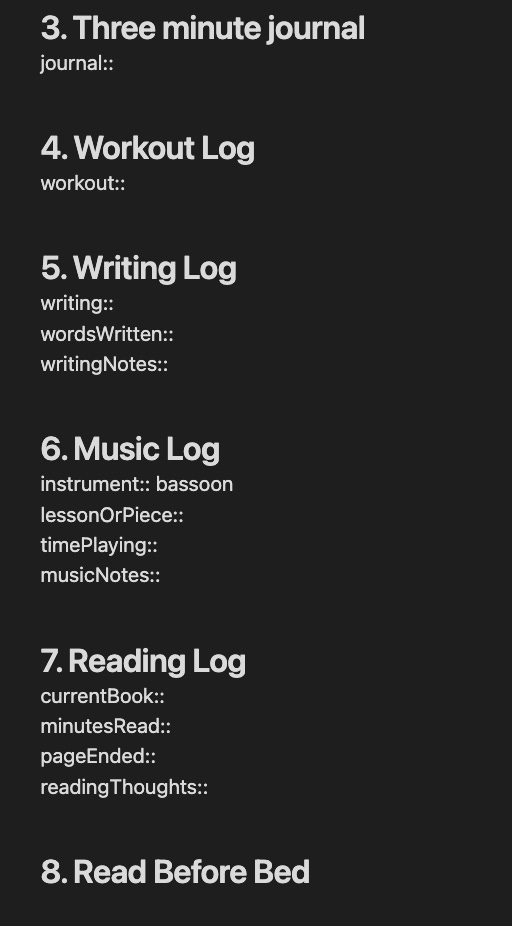Previously, I discussed how one can use the Obsidian platform to build a network of linked notes. That post described the basic idea behind Obsidian, as well as some of the tools I use. If you missed it, catch up here:
There, I described fleeting, handwritten, literature, and Zettelkasten notes; but I left the topic of personal journal notes for this article. Here, I discuss taking journal notes and using these reflections to design my personal goals.
I use three levels of periodic notes:
First, I use a daily note to journal, log activities, and check in with my mantra (my goals and values).
Second, I use a quarterly note to look into the future and adjust my mantra to align with my aspirations.
Finally, I use a yearly note to review the past year and reflect on which things went well or poorly.
daily notes
First, the daily note.
Obsidian has a built in plug-in for "Daily Notes" that generates a new note each day, from a template note that you can design yourself. These notes will automatically be titled with the date, and can be great for keeping a daily journal. However, there are many ways to use these daily notes beyond journaling. Like last post, if you care to know, I'll expound my approach here.
In my daily note template, I have a morning section and an evening section. The morning section is designed to be the first thing I look at when I get out of bed, and the evening section is designed to be the last (except for a book before bed). I’ll start with the evening section.
evening section
1. Todoist nighttime routine
Before bed, the first thing I do is go through a quick list of tasks on my Todoist (more on this next post), which include nightly routines like charge computer, check tomorrow's calendar, or take my multivitamin.
2. habit tracker
I then move on to my habit tracker. As I will discuss more in the morning section below, I have a designated list of constraints in order to build better habits. I note how many of these habits I met that day by placing a number in the stuckToMantra:: field. Then, I use the Tracker plugin with the following script:
```tracker
searchType: dvField
searchTarget: stuckToMantra
datasetName: Stuck To Mantra
startDate: 2025-06-27
line:
```This generates a plot where I can easily see how many of my habits I am meeting over time. In the above example image, I have 5 habits, and the line chart tracks how many of these five habits I’ve stuck to over the last few days.
3. journal
Next I write a journal entry. I mandate at least three minutes of writing and type my daily recap after the journal:: tag. I collect all of my journal entries in a note titled "journal" with the following dataview script:
```dataview
table
journal
from "Daily Notes"
sort file.name desc
```Then in the “journal” note I can scroll through all of my entries:
*Note that this script pulls from a folder called “Daily Notes,” since all of my daily notes are saved to a folder named “Daily Notes.” Change to your folder location if needed.
4-7. logs
After my journal entry, I have a series of logs. Here, I fill in my workouts, writing, music practice, and reading for the day. I use dataview fields with double colons and create a designated note with a dataview table tracking each of these fields. For example, I have a “music practice log” note with the table
```dataview
table
instrument as "Instrument", lessonOrPiece as "Practiced", timePlaying as "Time", musicNotes as "Notes"
from "Daily Notes"
sort file.ctime desc
```8. read
I finish with a reminder to read before bed.
Thus concludes the evening portion of my daily note.
morning section
In the morning, the first thing I do is read my mantra. This is a dedicated note in Obsidian that contains the following sections:
I've collapsed each section for privacy, but under each heading I have a few bullet points that I read every day:
The gratitude section tells me to pause and practice gratitude for something in my life.
The core principles section contains what I consider the cardinal virtues for being a good person. Under each virtue is a short (<10 word) description of my understanding of that virtue.
The long-term goals section contains a few goals with a timeline ~3 years.
The short-term goals section contains a few goals with a timeline < 1 year.
The constraints section details some things that I can/can't do in order to build good habits and avoid vices (i.e. screen time limits, dietary guidelines, etc.).
I treat my mantra like an unbreakable law code for my life. This seems extreme, but it is actually really powerful, because as long as you have carefully outlined your core principles, goals, and restraints; then living strictly by your mantra will be beneficial.
As a result, I've put a lot of effort into deciding what goes into my mantra. I have a “justification” note, linked at the top of the mantra, which has extended descriptions of why I chose each part of my mantra. This note is much too long to read every day, but if my willpower ever falters with regards to a certain virtue or goal, I can check this “justification” note to remember why my previous self wanted to commit to said virtue or goal.
Of course, there are times when I no longer think a part of my mantra is in my best interest. In fact, my mantra has gone through many edits over the course of time. Not only that, but I have a built-in system that encourages my mantra to grow with me, which brings me to my quarterly note.
quarterly note
Moving on from daily notes, I also fill out a quarterly note every three months. You can use the Periodic Notes plugin, or just generate a new quarterly note manually (since you only have to do it once a quarter).
The following is the template for my quarterly note (the basis for this was borrowed from elsewhere but I have sorrily forgotten…maybe Robert Talbert?):
Revisit Goals
Take 2 minutes for each section. Imagine that whatever you write on this piece of paper will come true within the designated time frame. Think of it as a wishlist describing your ideal life. Ask yourself,
IF I COULD BE ANYTHING, DO ANYTHING, OR HAVE ANYTHING, WHAT WOULD IT BE?
Write every single thing that comes to mind and be as specific as possible. Lastly, do not feel the need to be realistic or justify your dreams. Just write.
3 Months
1 Year
3 Years
Lifetime
Use these exercises to revisit goals and mantra
Read [[Mantra]]
Also read full list of [[constraints]]
Are your goals in alignment with your passions? Are your subgoals optimally chosen to reach your goals? Do your daily habits as defined by your mantra help you reach your goals? Write all of your thoughts and the changes you want to make.
Read the quarterly notes from: last quarter, last year, and three years ago.
Each time, pay special attention to the brainstorming that refers to where you are now. Note findings. Also note significant differences in past mantra design. Add any insights here, without editing above.
Solidify your results
Update [[Mantra]], [[Mantra Justification]], [[constraints]],and [[daily note template]]
As you can see, the quarterly note is a built in way to update my mantra in order to align with my current expectations. My favorite part of this exercise is reading past quarterly notes from specific time periods ago. For example, when I read the quarterly note from three years ago and read what dreams I had for my current self, I can see how close I have come to those hopes and dreams. Sometimes you are where you hoped to be, which is satisfying, and sometimes you are hopelessly far from the mark, which leads to some self-reflection.
yearly note
I also fill out a yearly note, sometime around New Year’s each year. Again, I think I borrowed many of these prompts from somewhere, let me know if you find where. Every year I fill out this questionnaire:
Review last year's journal entries and last year's yearly note. Leave notes here:
From 1-10, how do you feel overall about this past year?
What advice would you give yourself at the beginning of the year?
What was the most memorable part of this past year? Describe it.
What were the three biggest lessons you've learned in the past year? What is one way to incorporate these lessons into your life?
Are you happy with how you spent your time? If not, what steps can you take next year to adjust them?
What did you accomplish this past year? What are you most proud of?
How are you different between this past year and the year before it?
What or who are you especially grateful for this past year?
Name three things you can improve on this upcoming year. What are concrete actions you can take to work towards these improvements?
Go back to your goals and check off any goals or sub-goals you accomplished.
Look ahead to your schedule for the next 3 years.
Break down large upcoming tasks into sub-tasks.
The first task is a big one and can take several sittings. Reading your journal from the past year can be boring, painful, exciting, and/or nostalgic. But it is essential for reflecting on your use of time and energy, and I’ve found it super interesting to consider your past activities from a more objective, removed perspective. After doing the first item, you should be primed to fill out the rest of the questions.
If your quarterly notes are aligned with the yearly cycle, you will also have a quarterly note to fill out along with your yearly note. It can be helpful to consider your yearly note reflections as you complete your quarterly note, especially in regards to any potential mantra modifications.
conclusion
I use my daily note every day to check in with my mantra and log things about my life.
I use quarterly notes to dream about the future and adjust my mantra if I'm off course.
Finally, I use yearly notes to look backwards and reflect about what I've done, which is helpful in approaching the new year.
Doing these things has helped me live more intentionally and work more efficiently towards my goals. Maybe some of these things might be helpful to you as well.
Next time, I'll conclude this series describing how Todoist can help organize and complete tasks:
((finding something to do with todoist)) - TBD
Also, check out the first two posts in this series if you haven't already:










